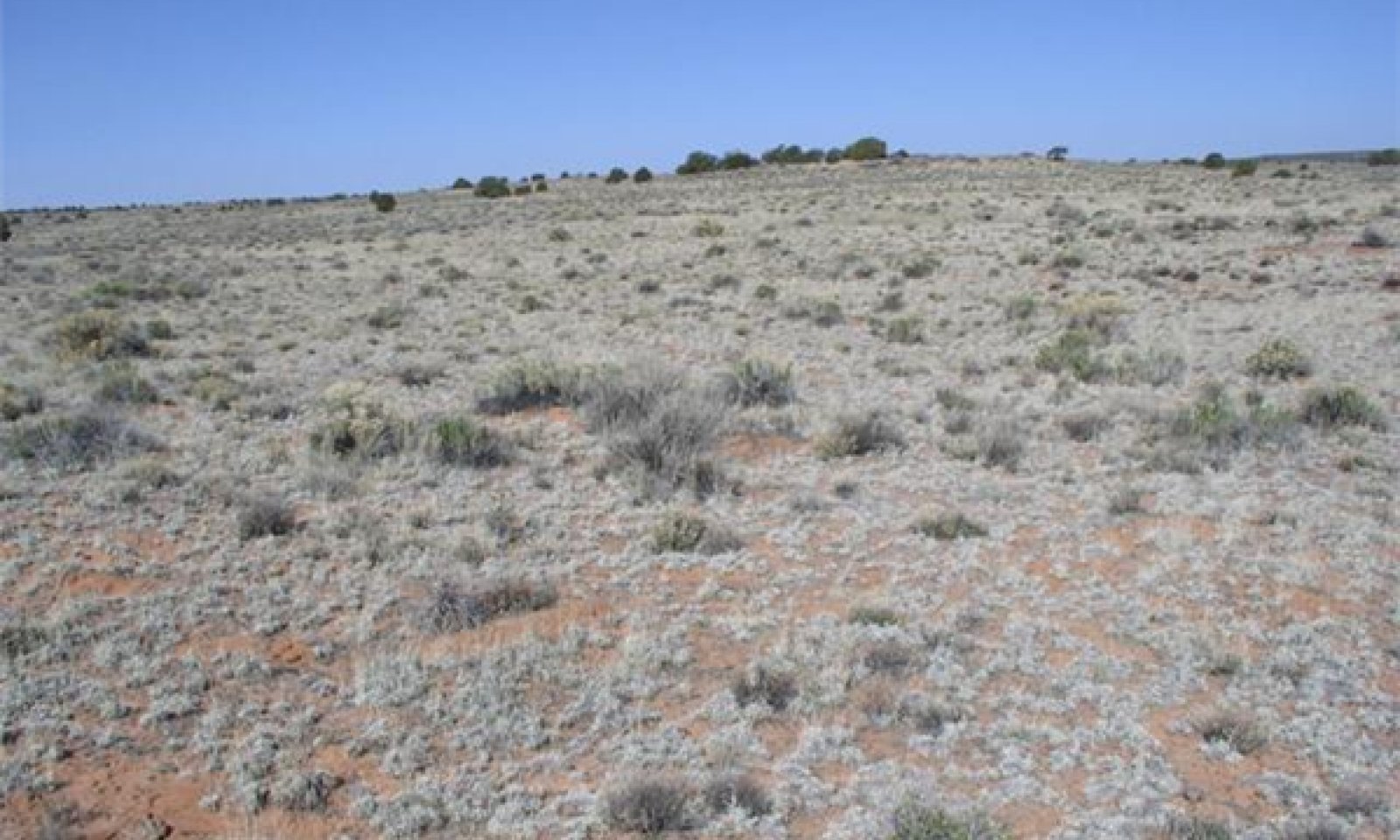

Natural Resources
Conservation Service
Ecological site R035XC315AZ
Sandy Upland 10-14" p.z.
Accessed: 12/21/2025
General information
Provisional. A provisional ecological site description has undergone quality control and quality assurance review. It contains a working state and transition model and enough information to identify the ecological site.
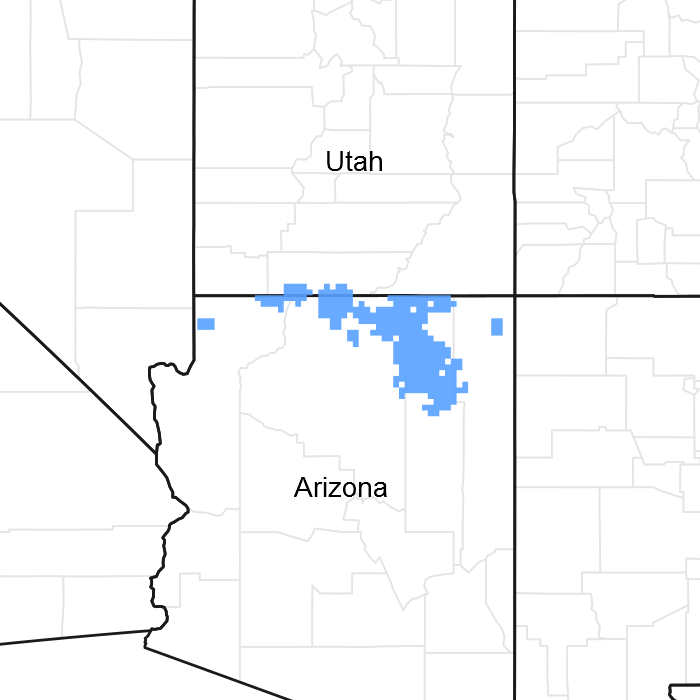
Figure 1. Mapped extent
Areas shown in blue indicate the maximum mapped extent of this ecological site. Other ecological sites likely occur within the highlighted areas. It is also possible for this ecological site to occur outside of highlighted areas if detailed soil survey has not been completed or recently updated.
MLRA notes
Major Land Resource Area (MLRA): 035X–Colorado Plateau
Common Resource Area 35.3 – Colorado Plateau Sagebrush – Grasslands
This Common Resource Area occurs within the Colorado Plateau Physiographic Province and is characterized by a sequence of flat to gently dipping sedimentary rocks eroded into plateaus, valleys and deep canyons. Elevations for the Common Resource Area where this ecological site may occur range from 4800 to 6700 feet and precipitation averages 10 to 14 inches. The elevation range is lower (about 4500 to 6000 ) on the western edge of the Colorado Plateau along the Grand Canyon, and moves up about 500 to 800 feet higher on the eastern side in the areas of the Navajo and Hopi Indian Reservations due to rain shadow effects from the Kaibab Plateau and Mogollon Rim. Common vegetation in this region includes Wyoming big sagebrush, Utah juniper, Colorado pinyon - cliffrose, Mormon tea, fourwing saltbush, blackbrush Indian ricegrass, needle and thread, western wheatgrass Galleta, black grama, blue grama, and sand dropseed. Sedimentary rock classes dominate the plateau with volcanic fields occurring for the most part near its margin. The soil temperature regime is mesic and the soil moisture regime is ustic aridic.
Table 1. Dominant plant species
| Tree |
Not specified |
|---|---|
| Shrub |
(1) Artemisia |
| Herbaceous |
(1) Achnatherum hymenoides |
Physiographic features
This ecological site is found on nearly level to gently rolling uplands to partially stabilized or stabilized dunes on plateaus, fans and abandonded stream terraces. The soils are deep to very deep to any plant root restricting layer. The texture of the soil throughout the profile is generally sandy loams to loamy coarse sand. The slope of the site is generally 1 to 10 percent, but may be as high as 15 percent.
Table 2. Representative physiographic features
| Landforms |
(1)
Plateau
(2) Fan (3) Dune |
|---|---|
| Flooding frequency | None |
| Ponding frequency | None |
| Elevation | 4,800 – 6,500 ft |
| Slope | 15% |
| Aspect | Aspect is not a significant factor |
Climatic features
Winter summer moisture ratios range from 70:30 to 60:40. Late spring is usually the driest period, and early fall moisture can be sporadic. Summer rains fall from June through September; moisture originates in the Gulf of Mexico and creates convective, usually brief, intense thunderstorms. Cool season moisture from October through May tends to be frontal; it originates in the Pacific and the Gulf of California and falls in widespread storms with longer duration and lower intensity. Precipitation generally comes as snow from December through February. Accumulations above 12 inches are not common but can occur. Snow usually lasts for 3-4 days, but can persist much longer. Summer daytime temperatures are commonly 95 - 100 F and on occasion exceed 105 F. Winter air temperatures can regularly go below 10 F and have been recorded below - 20 F.
Table 3. Representative climatic features
| Frost-free period (average) | 168 days |
|---|---|
| Freeze-free period (average) | 193 days |
| Precipitation total (average) | 14 in |
Figure 2. Monthly precipitation range
Figure 3. Monthly average minimum and maximum temperature
Influencing water features
The soil moisture on this ecological site comes from precipitation. The site does not benefit significantly from run-on moisture. The sandy surface texture of the soil allows the site to capture the majority of both gentle winter storms and intense summer thunderstorms with little or no runoff.
Soil features
The soils associated with this ecological site are deep to very deep to any plant root restricting layer. The soil textures throughout the profile range from loamy fine sands to coarse sands. Where the site has been stable for long periods of time, there may be some accumulation of carbonates at moderate depths that can help the site retain more soil moisture within the root zone. The soil ranges from nuetral to moderately alkaline (pH 6.6 to 8.4). The permeability is rapid to very rapid and the soil profile can capture both gentle winter rains and intense summer thunderstorms. The available water capacity is low. Wind erosion is a severe problem if the vegetative cover is lost.
This ecological site has been correlated to the following soil survey map unit components:
Shivwits Area (AZ623) 53-Mespun;
Mohave County NE part (AZ625) 37- Mido, 38-Mido;
Coconino County North Kaibab part (AZ629)2-Pensom, 3-Pensom, 5-Pensom/Barx, 37-Pensom, 38-Pensom, 39 Pensom, 10 Curhollow, 23-Klondike, 10-Mellenthin , 25-Mellenthin, 26-Mellenthin, 38-Arches;
Little Colorado River Area (AZ707) 3-Mido
Navajo Mountain Area (AZ711) 11-Pensom, 20-Mespun/Bispen, 28-Mido, 32-Pensom, 33-Pinavetes, 34 Pinavettes/ Pinavettes moderately deep, 39-Mido, 43 Mido
Chinle Area (AZ713)6-Mido, 10-Mido, 41-Mido
Hopi Area (AZ714) 17-Mido, 18-Mido, 19 Mido;
Fort Defiance Area AZ/NM (AZ715) 53-Tonalea, 61-Pinavettes family, 81-Pinavettes family & 83 Pinavettes family
Shiprock Area AZ/NM (AZ717) 306-Mido, 314 Mido.
Table 4. Representative soil features
| Parent material |
(1)
Eolian sands
–
sandstone
(2) Residuum – mudstone |
|---|---|
| Surface texture |
(1) Loamy fine sand (2) Sand (3) Coarse sandy loam |
| Family particle size |
(1) Sandy |
| Drainage class | Excessively drained |
| Permeability class | Rapid to very rapid |
| Soil depth | 60 in |
| Surface fragment cover <=3" | 2% |
| Surface fragment cover >3" | Not specified |
| Available water capacity (0-40in) |
1.92 – 3.66 in |
| Calcium carbonate equivalent (0-40in) |
Not specified |
| Electrical conductivity (0-40in) |
2 mmhos/cm |
| Sodium adsorption ratio (0-40in) |
Not specified |
| Soil reaction (1:1 water) (0-40in) |
6.6 – 8.4 |
| Subsurface fragment volume <=3" (Depth not specified) |
1% |
| Subsurface fragment volume >3" (Depth not specified) |
Not specified |
Ecological dynamics
An ecological site is not a precise assemblage of species for which the proportions are the same from place to place or from year to year. In all plant communities, variability is apparent in productivity and occurrence of individual species. Spatial boundaries of the communities; however, can be recognized by characteristic patterns of species composition, association, and community structure. The historic climax plant community for this ecological site has been described by sampling relict or relatively undisturbed sites and/or reviewing historic records. The historic climax plant community is the plant community that evolved over time with the soil forming process and long term changes in climatic conditions of the area. It is the plant community that was best adapted to the unique combination of environmental factors associated with the site.
Natural disturbances, such as drought, fire, grazing of native fauna, and insects, are inherent in the development and maintenance of these plant communities. The effects of these disturbances are part of the range of characteristics of the ecological site. Fluctuations in plant community structure and function caused by the effects of natural disturbances help establish the boundaries and characteristics of an ecological site. They are accounted for as part of the range of characteristics of the ecological site. Recognizable plant community phases are identified in the reference state of the ecological site. Some sites may have a small range of variation, while others have a large range. Some plant community phases may exist for long periods of time, while others may only occur for a couple of years after a disturbance.
If there is significant loss of soil surface through erosion, if there a loss of the soil stability on the site due to active erosion on the site, if the hydrology of the site is significantly modified by increasing runoff amounts and/or patterns, if there are changes in availability of surface and subsurface water, or if the biotic integrity of the site is altered though changes in plant structural and functional types or the introduction of non-native species, then potential of the ecological site to return to the historic climax plant community can be lost, or restoration would require significant inputs . The site deterioration results in the crossing of a threshold or irreversible boundary to another state, or equilibrium, for the ecological site. There may be multiple states possible for an ecological site, determined by the type and or severity of disturbance.
The known states and transition pathways for this ecological site are described in the state and transition model. Within each state, there may be one or more known plant community phases. These community phases describe the different plant community that can be recognized and mapped across this ecological site. The state and transition model is intended to help land users recognize the current plant community on the ecological site, and the management options for improving the plant community to the desired plant community.
Plant production data provided in this site description is standardized to the air-dry weight of one year's growth. The plant communities described in this site description are based on near normal rainfall years.
State and transition model

Figure 4. 353 SandyUpland S&T
More interactive model formats are also available.
View Interactive Models
More interactive model formats are also available.
View Interactive Models
Click on state and transition labels to scroll to the respective text
State 1 submodel, plant communities
State 2 submodel, plant communities
State 3 submodel, plant communities
State 4 submodel, plant communities
State 1
Reference State
Community 1.1
HIstoric Climax Plant Community

Figure 5. Grassland with shrubs
The historic climax plant community is composed of mid and short grasses with a moderate percentage of forbs and shrubs. There is a mixture of both cool and warm season grasses and half-shrubs. Plant species most likely to invade or increase on this site when it deteriorates are sand sagebrush, big sagebrush, rabbitbrush, annuals, sandhill muhly, wooly groundsel, and snakeweed.
Figure 6. Annual production by plant type (representative values) or group (midpoint values)
Table 5. Annual production by plant type
| Plant type | Low (lb/acre) |
Representative value (lb/acre) |
High (lb/acre) |
|---|---|---|---|
| Grass/Grasslike | 275 | 400 | 500 |
| Shrub/Vine | 100 | 150 | 200 |
| Tree | 0 | 20 | 65 |
| Forb | 20 | 30 | 50 |
| Total | 395 | 600 | 815 |
Figure 7. Plant community growth curve (percent production by month). AZ3501, 35.3 10-14" p.z. needle and thread. Growth starts in spring and extends into summer, plants may be green in the fall..
| Jan | Feb | Mar | Apr | May | Jun | Jul | Aug | Sep | Oct | Nov | Dec |
|---|---|---|---|---|---|---|---|---|---|---|---|
| J | F | M | A | M | J | J | A | S | O | N | D |
| 0 | 0 | 10 | 20 | 30 | 10 | 5 | 5 | 10 | 10 | 0 | 0 |
Figure 8. Plant community growth curve (percent production by month). AZ3531, 35.3 10-14" p.z. all sites. Growth begins in the spring and continues through the summer..
| Jan | Feb | Mar | Apr | May | Jun | Jul | Aug | Sep | Oct | Nov | Dec |
|---|---|---|---|---|---|---|---|---|---|---|---|
| J | F | M | A | M | J | J | A | S | O | N | D |
| 0 | 1 | 3 | 17 | 18 | 10 | 19 | 20 | 10 | 1 | 1 | 0 |
Community 1.2
Shubs with Grasses Community
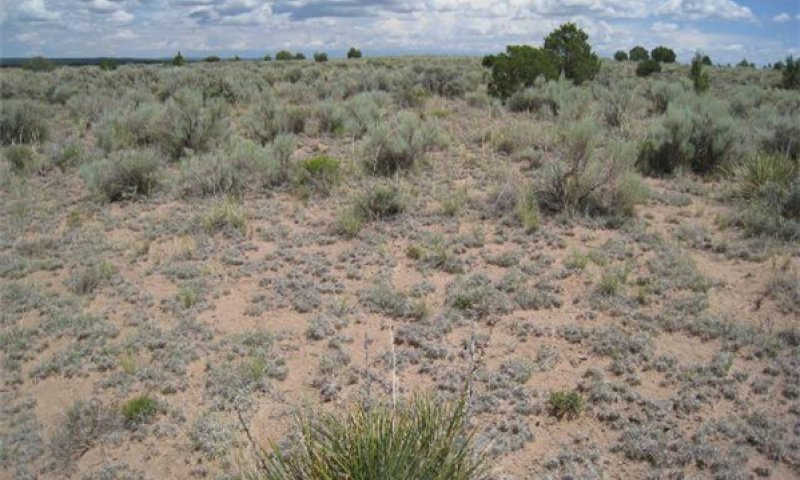
Figure 9. Shrubland with Grasses
This plant community is characterized by a mix of shrubs and grasses. There is a slight increase of large and half shrubs, decrease in perennial grasses, especially cool season grasses. Grasses in decline include black grama, needle and thread and Indian ricegrass.
Pathway 1.1a
Community 1.1 to 1.2


Unmanaged grazing, long term winter dominated precipitation, and/or drought that reduces perennial warm and cool season grasses.
Pathway 1.2a
Community 1.2 to 1.1


Managed grazing, adequate precipitation
Conservation practices
| Prescribed Grazing |
|---|
State 2
Sagebrush State
Community 2.1
Sagebrush Dominated Community
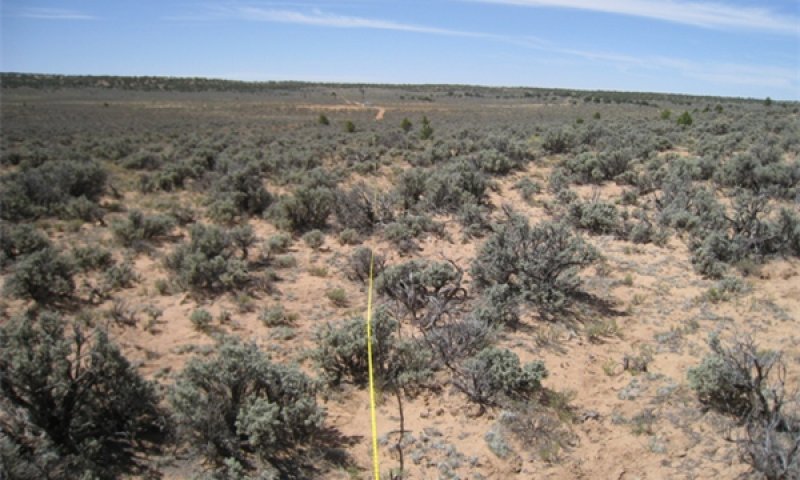
Figure 10. Sagebrush Dominated Site
Sagebrush species such as big sagebrush and/or sand sagebrush. Other shrubs in moderate amounts include rabbitbrush species and snakeweed. In the understory is a mix of warm and cool season grasses dominanted by blue grama, Indian ricegrass, squirreltail, and dropseeds.
Community 2.2
Sagebrush with Scattered Juniper Community
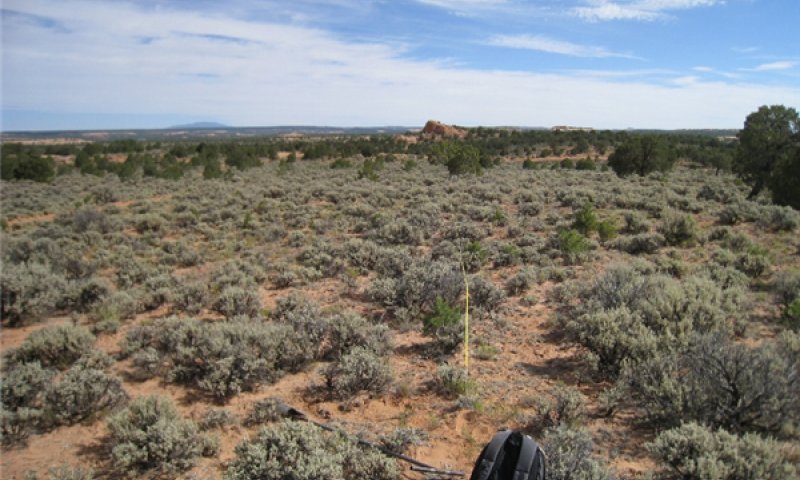
Figure 11. Sagebrush with Scattered Junipers
The dominant aspect of this site is a shrubland with a scattered overstory of junipers. Dominant shrubs include sagebrush, snakeweed, Bigelow rubber rabbitbrush and other native shrubs. The herbaceous understory is dominated by blue grama, needle and thread, sand dropseed, sandhill muhly and Indian ricegrass.
Pathway 2.1a
Community 2.1 to 2.2


Unmanaged grazing, summer drought, seed source for juniper
Pathway 2.2a
Community 2.2 to 2.1


Natural patchy fire, well managed grazing, and adequate precipitation
Conservation practices
| Prescribed Burning | |
|---|---|
| Prescribed Grazing |
State 3
Juniper / Shrubs State
Community 3.1
Juniper with Shrub Understory Community
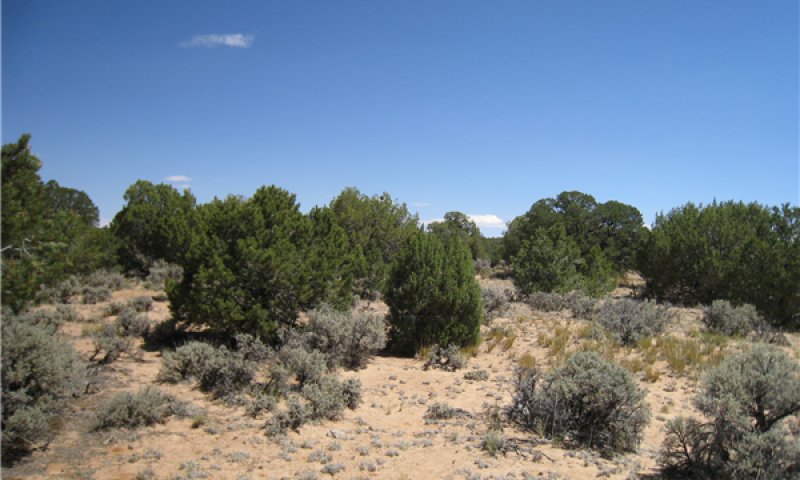
Figure 12. Juniper Overstory
Juniper and occasional pinyon pine increases to dominate overstory with a shrub understory. Shrubs species include sagebrush, snakeweed, rabbitbrush, Cultler's mormon tea and antelope bitterrbrsh. There is also a increase of introduced annual forbs and grasses. Dominant grasses are sandhill muhly, blueg grama, sand dropseed and Indian ricegrass.
State 4
Disturbed Surface State
Community 4.1
Tree/Shrub with Introduced Annuals Community
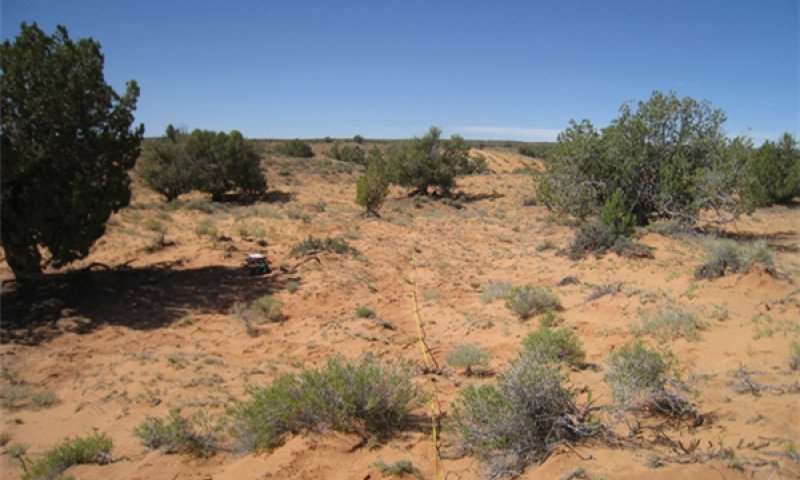
Figure 13. Disturbed Surface with Shrub-Trees
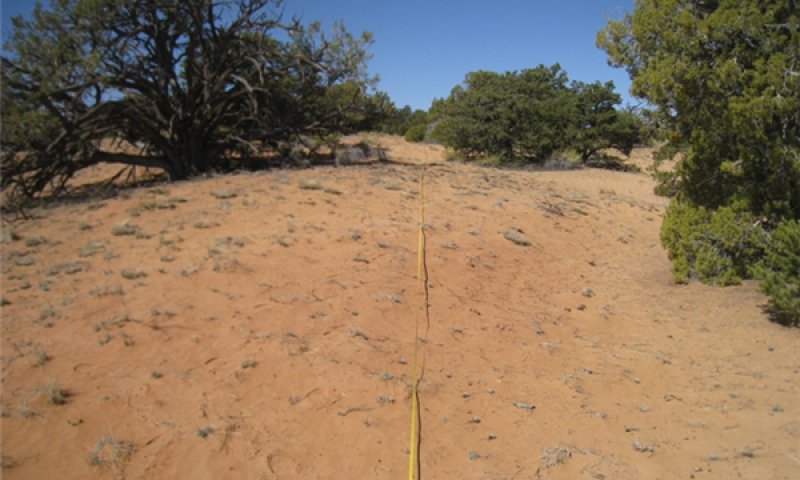
Figure 14. Disturbed surface with Trees
The dominant aspect of the site is woody overstory of shrubs and trees with a herbaceous understory dominated by forbs. This site has a high degree of bare ground with active signs of soil erosion. Bare ground can reach as high as 85%, but in wet years can be as low as 35% with high forb production. Plant understory composition by weight for forbs and annual grasses can range from 25-45%, but can be as high as 80% during high precipitation events. Dominate grasses include sandhill muhly, dropseeds and Indian ricegrass. Dominate shrubs include Bigelow rubber rabbitbrush, Greene's rabbtibrush, sand sagebrush, frosted mint, antelope bitterbrush and sand buckwheat. Tree canopy can vary, but is dominated by juniper species.
Transition T1A
State 1 to 2
Loss of biotic integrity due to loss of perennial grasses and shrub encroachment, causing some loss of soil site stability and hydrologic function with more stability and infiltration under shrubs.
Transition T1B
State 1 to 3
Loss of biotic integrity due to loss of perennial grasses and juniper and shrub encroachment, causing some loss of soil site stability and hydrologic function.
Transition T2A
State 2 to 3
Further loss of biotic integrity with increasing juniper. Soil site stability and hyrdologic function at least moderately departed from the reference state due to changes in infilration pattern.
Transition T2B
State 2 to 4
Drought, unmanaged grazing and/or fire removes the perennial herbaceous component of the plant community. Introduced annual grasses and forbs move into the plant community further reducing the biotic integrity of the site. Soil site stability is lost except around remaining trees and shrubs.
Restoration pathway R3A
State 3 to 1
Reduction of juniper and other woody shrubs that have encroached on the site. Seeding or planting where remaining seed source is inadequate. Well managed grazing before and after treatment.
Conservation practices
| Brush Management | |
|---|---|
| Prescribed Burning | |
| Range Planting | |
| Prescribed Grazing |
Transition T3A
State 3 to 4
Drought, fire, and/or unmanaged grazing reduce the perennial herbaceous component and some of the shrubs further reducing the biotic integrity of the site. Introduced annual grasses and forbs move into the plant community. Soil site stability and hydrogic function are at least moderately departed from the reference state.
Restoration pathway R4A
State 4 to 2
Reduction of junipers and shrub species that have encroached on the site. Seeding where there is not an adequate seed source of the desired species. Control of introduced grasses and fobs may be needed if they are significant on the site. Well managed grazing is required before and after treatment.
Conservation practices
| Brush Management | |
|---|---|
| Prescribed Burning | |
| Range Planting | |
| Prescribed Grazing | |
| Herbaceous Weed Control |
Restoration pathway R4B
State 4 to 3
Control of introduced annuals and seeding of native perennial grasses where the existing seed source is not adequate. Control of some tree and shrub encroachment may be needed. Well managed grazing is required before and after treatments.
Conservation practices
| Brush Management | |
|---|---|
| Prescribed Grazing | |
| Herbaceous Weed Control |
Additional community tables
Table 6. Community 1.1 plant community composition
| Group | Common name | Symbol | Scientific name | Annual production (lb/acre) | Foliar cover (%) | |
|---|---|---|---|---|---|---|
|
Grass/Grasslike
|
||||||
| 1 | Dominant Grasses | 300–450 | ||||
| Indian ricegrass | ACHY | Achnatherum hymenoides | 130–225 | – | ||
| needle and thread | HECOC8 | Hesperostipa comata ssp. comata | 65–120 | – | ||
| James' galleta | PLJA | Pleuraphis jamesii | 30–60 | – | ||
| black grama | BOER4 | Bouteloua eriopoda | 30–60 | – | ||
| blue grama | BOGR2 | Bouteloua gracilis | 30–60 | – | ||
| squirreltail | ELELE | Elymus elymoides ssp. elymoides | 30–60 | – | ||
| 2 | Other Grasses | 80–200 | ||||
| sandhill muhly | MUPU2 | Muhlenbergia pungens | 5–40 | – | ||
| spike dropseed | SPCO4 | Sporobolus contractus | 5–40 | – | ||
| sand dropseed | SPCR | Sporobolus cryptandrus | 5–40 | – | ||
| mesa dropseed | SPFL2 | Sporobolus flexuosus | 5–40 | – | ||
| Grass, annual | 2GA | Grass, annual | 0–30 | – | ||
| Grass, perennial | 2GP | Grass, perennial | 0–30 | – | ||
| Fendler's threeawn | ARPUF | Aristida purpurea var. fendleriana | 5–30 | – | ||
|
Forb
|
||||||
| 3 | Forbs | 25–50 | ||||
| squirreltail | ELELE | Elymus elymoides ssp. elymoides | 32–65 | – | ||
| Forb, perennial | 2FP | Forb, perennial | 0–20 | – | ||
| globemallow | SPHAE | Sphaeralcea | 0–20 | – | ||
| Rocky Mountain zinnia | ZIGR | Zinnia grandiflora | 0–20 | – | ||
| Forb, annual | 2FA | Forb, annual | 0–10 | – | ||
|
Shrub/Vine
|
||||||
| 5 | Dominant Shrubs | 100–200 | ||||
| sand sagebrush | ARFI2 | Artemisia filifolia | 75–100 | – | ||
| blue grama | BOGR2 | Bouteloua gracilis | 32–98 | – | ||
| Wyoming big sagebrush | ARTRW8 | Artemisia tridentata ssp. wyomingensis | 25–75 | – | ||
| jointfir | EPHED | Ephedra | 40–75 | – | ||
| 6 | Other Shrubs | 0–100 | ||||
| James' galleta | PLJA | Pleuraphis jamesii | 32–98 | – | ||
| fourwing saltbush | ATCA2 | Atriplex canescens | 25–40 | – | ||
| rubber rabbitbrush | ERNAB | Ericameria nauseosa ssp. nauseosa var. bernardina | 25–40 | – | ||
| broom snakeweed | GUSA2 | Gutierrezia sarothrae | 5–30 | – | ||
| winterfat | KRLA2 | Krascheninnikovia lanata | 5–30 | – | ||
| pricklypear | OPUNT | Opuntia | 5–30 | – | ||
| yucca | YUCCA | Yucca | 5–30 | – | ||
|
Tree
|
||||||
| 7 | Trees | 0–65 | ||||
| Utah juniper | JUOS | Juniperus osteosperma | 0–65 | – | ||
| twoneedle pinyon | PIED | Pinus edulis | 0–65 | – | ||
Interpretations
Animal community
This site is suitable for grazing throughout most of the year with shrubs providing forage during the period when snow covers palatable grasses. When the ground cover is removed, this site is highly subject to wind erosion. However, the site responds quickly to proper management.
The habitat diversity of this shrub-grassland is restricted due to the lack of a tree overstory and permanent waters. Some animals may tend to avoid the site when the plant cover is sparse because of the poor traction properties of dry sand. This may give predators a slight advantage. Deer, rabbits, and buteos (hawks) typify the fauna on the site. Maintaining the site in good or excellent conditions provides the greatest habitat diversity for wildlife.
Recreational uses
This site may occur near the base of sandstone cliffs as rolling hills or fans or on undulating plateaus with sandstone parent material.
The winters are cold and summers are warm. Late spring, summer and fall are the most pleasant seasons for recreation activities.
Activities may include hunting, cross-country riding, photography, and wildlife observation.
Supporting information
Type locality
| Location 1: Mohave County, AZ | |
|---|---|
| Township/Range/Section | T42N R6W S31 |
| General legal description | Colorado City United Effort farm field number one. (conservation plan map) |
Other references
Updates and revisions for this ESD were conducted as part of a 2007-2012 Interagency Technical Assistance Agreement between the Bureau of Indian Affairs–Navajo Region and the NRCS-Arizona.
Contributors
Ken Gishi
Larry D. Ellicott
Steve Barker
Rangeland health reference sheet
Interpreting Indicators of Rangeland Health is a qualitative assessment protocol used to determine ecosystem condition based on benchmark characteristics described in the Reference Sheet. A suite of 17 (or more) indicators are typically considered in an assessment. The ecological site(s) representative of an assessment location must be known prior to applying the protocol and must be verified based on soils and climate. Current plant community cannot be used to identify the ecological site.
| Author(s)/participant(s) | Steve Cassady, Kyle Spencer, Tobiah Salvail |
|---|---|
| Contact for lead author | NRCS State Rangeland Management Specialist, Phoenix Az |
| Date | 05/30/2008 |
| Approved by | Steve Barker |
| Approval date | |
| Composition (Indicators 10 and 12) based on | Annual Production |
Indicators
-
Number and extent of rills:
None -
Presence of water flow patterns:
None -
Number and height of erosional pedestals or terracettes:
No pedestalling, but turf building of ¼ to ½ inch occurs on blue grama. Some mounding, 1 to 2 inches, on long-lived shrubs. -
Bare ground from Ecological Site Description or other studies (rock, litter, lichen, moss, plant canopy are not bare ground):
Bare ground is < or = 40 percent. -
Number of gullies and erosion associated with gullies:
None -
Extent of wind scoured, blowouts and/or depositional areas:
None -
Amount of litter movement (describe size and distance expected to travel):
No appreciable movement of litter. -
Soil surface (top few mm) resistance to erosion (stability values are averages - most sites will show a range of values):
A thin crust or “cap” will develop on the soil surface providing some protection against erosion. This crust is easily broken. -
Soil surface structure and SOM content (include type of structure and A-horizon color and thickness):
The surface of soils associated with this site are single grained; loose. Color is reddish yellow (7.5YR 6/6) dry, yellowish red (7.5YR 4/6) moist. -
Effect of community phase composition (relative proportion of different functional groups) and spatial distribution on infiltration and runoff:
Randomly scattered plants consisting of about 70 percent grasses, 25 percent shrubs and 5 percent forbs promote infiltration and reduce runoff. The average distance to the nearest perennial plant (fetch) is 2 inches, with the majority ranging from 0 to 3 inches, but occasionally as far as 5 inches. -
Presence and thickness of compaction layer (usually none; describe soil profile features which may be mistaken for compaction on this site):
None -
Functional/Structural Groups (list in order of descending dominance by above-ground annual-production or live foliar cover using symbols: >>, >, = to indicate much greater than, greater than, and equal to):
Dominant:
Grasses (60 to 75%) >> Shrubs (25 to 40%) > Forbs (5 to 10%).Sub-dominant:
Other:
Additional:
-
Amount of plant mortality and decadence (include which functional groups are expected to show mortality or decadence):
Due to the relatively droughty nature of these soils, drought, even short term, will result in plant mortality. In “normal” precipitation years mortality will be less than 10 percent. -
Average percent litter cover (%) and depth ( in):
-
Expected annual annual-production (this is TOTAL above-ground annual-production, not just forage annual-production):
Average annual production on this site is expected to be 600 to 700 lbs/ac. in a year of average annual precipitation. -
Potential invasive (including noxious) species (native and non-native). List species which BOTH characterize degraded states and have the potential to become a dominant or co-dominant species on the ecological site if their future establishment and growth is not actively controlled by management interventions. Species that become dominant for only one to several years (e.g., short-term response to drought or wildfire) are not invasive plants. Note that unlike other indicators, we are describing what is NOT expected in the reference state for the ecological site:
Broom snakeweed (Gutierrezia sarothrae) is natural on the site, but disturbance may cause an increase in its abundance. -
Perennial plant reproductive capability:
All plants native to this site are adapted to the climate and are capable of producing seeds, stolons, and/or rhizomes except during the most severe droughts.
Print Options
Sections
Font
Other
The Ecosystem Dynamics Interpretive Tool is an information system framework developed by the USDA-ARS Jornada Experimental Range, USDA Natural Resources Conservation Service, and New Mexico State University.
Click on box and path labels to scroll to the respective text.